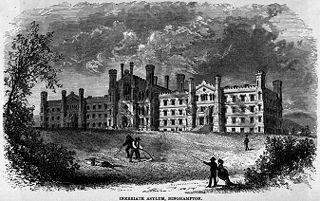
Binghamton is a city in, and the county seat of, Broome County, New York, United States. It lies in the state's hilly Southern Tier region near the Pennsylvania border, in a bowl-shaped valley at the confluence of the Susquehanna and Chenango Rivers. Binghamton is the principal city and cultural center of the Binghamton metropolitan area, home to a quarter million people. The population of the city itself, according to the 2010 census, is 47,376.

The Chenango Canal was a towpath canal built and operated in the mid-19th century in central New York in the United States. It was 97 miles long and for much of its course followed the Chenango River, along Rt. 12 N-S from Binghamton on the south end to Utica on the north end. It operated from 1834 to 1878 and provided a significant link in the water transportation system of the northeastern U.S., connecting the Susquehanna River to the Erie Canal.

The Utica Psychiatric Center, also known as Utica State Hospital, opened in Utica on January 16, 1843. It was New York's first state-run facility designed to care for the mentally ill, and one of the first such institutions in the United States. It was originally called the New York State Lunatic Asylum at Utica. The Greek Revival structure was designed by Captain William Clarke and its construction was funded by the state and by contributions from Utica residents.

The Boehlert Transportation Center at Union Station is a train station served by Amtrak and the Adirondack Scenic Railroad in Utica, New York. It is owned by Oneida County, and named for retired U.S. Rep. Sherwood Boehlert, R-New Hartford.

Edward Franc Jones was an American merchant, manufacturer, soldier, author and politician from New York.

Wilson Eyre, Jr. was an American architect, teacher and writer who practiced in the Philadelphia area. He is known for his deliberately informal and welcoming country houses, and for being an innovator in the Shingle Style.

Isaac Gale Perry (1822–1904), was a prolific New York State architect and builder. His works include New York State Inebriate Asylum, Monday Afternoon Club, Phelps Mansion and the First National Bank of Oxford.

The New York State Inebriate Asylum, later known as Binghamton State Hospital, was the first institution designed and constructed to treat alcoholism as a mental disorder in the United States. Located in Binghamton, NY, its imposing Gothic Revival exterior was designed by New York architect Isaac G. Perry and construction was completed in 1864. The building was declared a National Historic Landmark in 1997. In 2015, Binghamton University announced it had taken stewardship of the building and will proceed with plans for rehabilitation of the building.
Philip Hooker was an American architect from Albany, New York known for Hyde Hall, the facade of the Hamilton College Chapel, The Albany Academy, Albany City Hall, and the original New York State Capitol building.

The First Presbyterian Church is a historic church building in Utica, New York. The church and its related McKinnon House were added to the National Register of Historic Places in 1988. The structures are notable for their early twentieth century design and architecture.

The Roberson Mansion, part of the Roberson Museum and Science Center, is a home in Binghamton, New York. It is an Italian Renaissance style house, designed by Binghamton architect C. Edward Vosbury and built in 1904, and completed in 1907, for Alonzo Roberson Jr. and his wife Margaret Hays Roberson. It was built with all of the then modern conveniences: an elevator, central heat, combination gas and electric lighting, a dumb waiter, an intercom system, and a private bath for each bedroom.

The New Century Club is located at 253 Genesee Street in Utica, New York. It was added to the National Register of Historic Places in September, 1985. It is architecturally significant for its Greek Revival architecture, once characteristic of this part of the city of Utica. It is socially significant as the home of the New Century Club, a women's civic organization established in 1893 and "responsible throughout the early twentieth century for projects that notably improved Utica's educational system, outdoor recreational facilities and youth justice system."
Dwight James Baum was an American architect most active in New York and in Sarasota, Florida. His work includes Cà d'Zan, the Sarasota Times Building (1925), Sarasota County Courthouse (1926), early residences in Temple Terrace, Florida, Sarasota County Courthouse (1927), Pinecroft, West Side YMCA on 63rd Street between Central Park and Columbus Avenue, Columbus Circle (1934) and Hendricks Memorial Chapel.

Broome County Courthouse is a historic courthouse located at Binghamton in Broome County, New York. It is a massive 2 1⁄2-story structure, built on a raised foundation, in the form of a Latin Cross and topped with an elegant copper dome. Originally constructed in 1897–1898 in a "T" shape, the south wing was added in 1916-1917 to form the cross. It was designed by noted New York State architect Isaac G. Perry. The courthouse is located within the boundaries of the Court Street Historic District.

Railroad Terminal Historic District is a national historic district in Binghamton in Broome County, New York. The district includes 19 contributing buildings. Four of the buildings were directly related to Binghamton's rail passenger and freight operations, including the passenger station. Five buildings were built as warehouses, and ten were built to house retail activities with residential or office uses on the upper floors. The buildings were built between 1876 and 1910, with a major addition to one of them completed in 1932. This Delaware, Lackawanna and Western Railroad passenger station, with its Italian Renaissance campanile, was built in 1901. For most years of passenger service to Binghamton Delaware and Hudson Railway and Erie Railroad trains used the station 150 yards away.

J. Stuart Wells House, now the Ernest H. Parsons Funeral Home, is a historic home located at Binghamton in Broome County, New York, USA. It was built in 1867-1870 and designed by the noted New York State architect Isaac G. Perry. It is a 2 1⁄2-story brick dwelling on a cut stone foundation and topped by a hipped, cross-gabled roof. It was expanded in the 1940s-1950s and features a wrap-around porch. Also on the property is a 2-story brick carriage house.
Frederick Hamilton Gouge was an American architect practicing in Utica, New York.

William E. Haugaard was an American architect who served as the State Architect for the State of New York from 1928 to 1944. A number of his works have been listed on the National Register of Historic Places.

Alexander Pirnie Federal Building is a historic post office, courthouse, and custom house located at Utica, Oneida County, New York. It was named for Congressman Alexander Pirnie in 1984. It was listed on the National Register of Historic Places in 2015.

Applewood, also known as the Charles Stewart Mott House, is the former residence of Charles Stewart Mott. It was listed on the National Register of Historic Places in 1979.
















